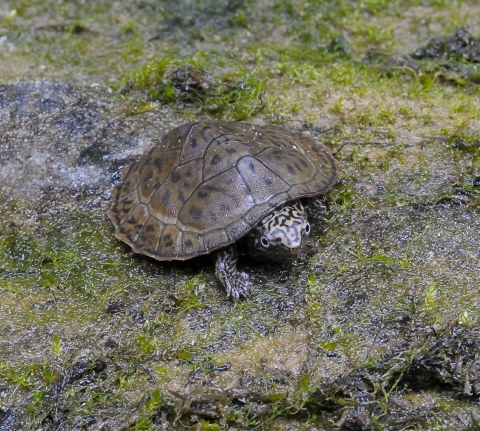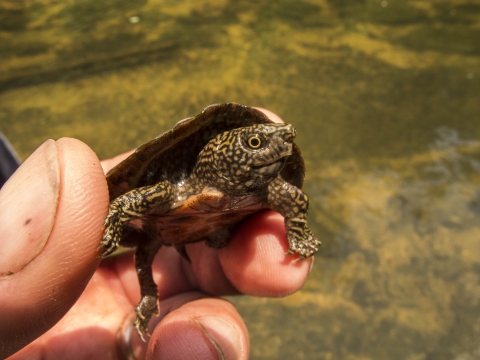Flattened Musk Turtle
US Fish & Wildlife Service Recommended Sampling Protocol
The flattened musk turtle (FMT) is a secretive cryptic species that is restricted to the Black Warrior River system, presently believed to occur upstream of the Bankhead Dam in portions of Blount, Cullman, Etowah, Fayette, Jefferson, Lawrence, Marshall, Tuscaloosa, Walker, and Winston Counties. It is seldom observed at the water surface because of its ability to augment its respiration subcutaneously, although it basks occasionally. It generally inhabits streams with drainage areas greater than 8 square miles, relatively clean substrates, and low turbidity, but may be found in suboptimal habitats. FMT may also be found in the lower reaches of smaller streams that flow into larger streams known to harbor FMT, and headwaters and margins of impounded lakes. Its primary food sources are macroinvertebrates, particularly snails, mussels, and insects. A general sampling protocol for this species should include the following considerations:
- Determine if the aquatic habitat is suitable for this species. Optimal habitat is permanent oligotrophic streams from one to five feet deep containing abundant rocky ledges, slabs, logs, debris, and pools. Generally, aquatic habitats that lack flowing water, relatively clean substrates, benthic macroinvertebrates, and low turbidity are unsuitable. Adequate quantitative and photographic documentation of unsuitable habitat must be presented to the Daphne Field Office if a field survey that includes trapping is thought to be unnecessary by the consultant.
- Visual searches in lieu of trapping are not acceptable unless a FMT is found and the consultant wishes to report that the FMT is present at a site. In this case, trapping would not be required unless the FMT must be held during construction activities.
- The requirement of a survey may be waived if the consultant wishes to concur with our records showing FMT occurrence within 5 miles of the project within the last 10 years and FMT do not need to be held during construction activities.
- Trapper must be experienced with flattened musk turtles and trapping procedures and have proper permits from the state of Alabama and USFWS. Traps should be tagged with Alabama Scientific Collection Permit numbers and the name and phone number of the trapper.
- To facilitate adequate trapping efficiency, FMT surveys should not be conducted during periods when they are typically inactive, when water temperatures are 15°C (59°F) and below (about the second week of October until about the first week of April).
- Sampling should include baited (chicken parts or canned sardines) trapping efforts (e.g., wire funnel traps) which should be set at 1 trap/20 m of stream length. Traps should be placed in deeper pools (if water temperature is at or below 25°C) and in areas that provide cover (e.g., large boulders, snags). Each trap should be set before nightfall and checked each morning (<14 hours after setting) for a minimum of three consecutive days and nights. If temperatures are above 25°C, traps should be placed in a manner that allows turtles to surface for air at night and then moved to deeper water in the morning and be checked no less than every six hours during the day. Water temperature should be checked at the depth of the trap. Chicken parts should be suspended from the top of the trap so that it can’t be eaten from outside the trap. Sardine cans should only be partially opened so that the turtles can’t get it out. Bait should be replaced with fresh bait within 48 hours.
- For projects that cross or release discharges into streams, the sampling area should extend at least 200 m upstream and at least 400 m (or maximum extent of discharge impacts) downstream.
- For projects that disturb a stream known to support FMT barriers should be placed approximately 65 m upstream of the project on shallow riffles and approximately 50 m downstream of the project on shallow riffles, where practical and possible. All FMT within the barriers should be removed and held (see #11 below) until the stream disturbance is complete. Barriers should be placed in such a manner that FMT cannot pass beyond them and should be maintained daily or more often as necessary. Certain situations may not be conducive to barriers and should be discussed with the Service on a case-by-case basis. The stream bottom should be restored as near as possible to pre-disturbance conditions.
- Accurate documentation of trapping success and locations of traps must be made.
- If any injury or mortality occurs, the surveyor shall follow the conditions for notification and disposition contained in their recovery permit issued under section 10(a)(1)(A) of the Endangered Species Act and implementing regulations found at 50 CFR 17.32.
These guidelines should be followed unless alternate instructions by the Service are provided in writing.
References:
Bailey, M.A. and K.A. Bailey. 1999. Flattened musk turtle mitigation, Southern Natural Gas Company North Alabama pipeline project. Final Report. Subcontract No. 99114, Project No. 6208-0250LSF. Prepared for ENSR by Conservation Services Southeast. Shorter, AL. 33 pp.
Dodd, C.K., Jr., K.M. Enge, and J.N. Stuart. 1988. Aspects of the biology of the flattened musk turtle, Sternotherus depressus, in northern Alabama. Bull. Florida State Mus., Biol. Sci. 34(1):1-64.
USFWS. 1997. Biological Opinion of the Southern Natural Gas Company’s North Alabama Pipeline Project (FERC 1997:4-15). June 4, 1997. Daphne Field Office. 12 pp.
USFWS. 1990. Flattened musk turtle recovery plan. Jackson, MS. 15 pp.


